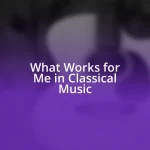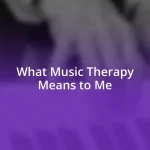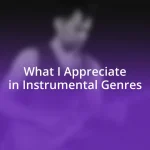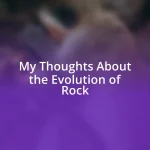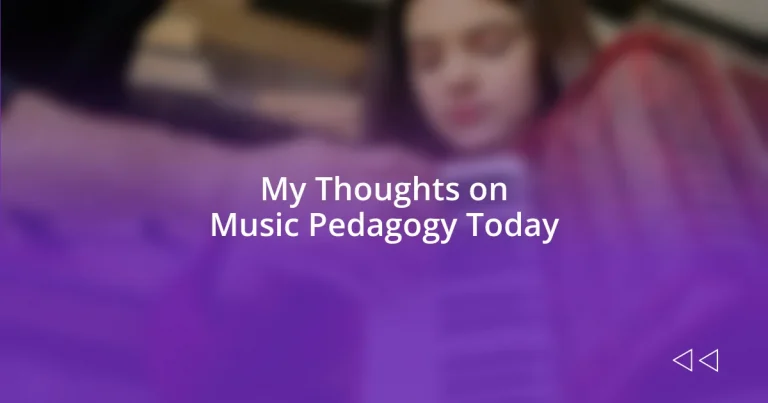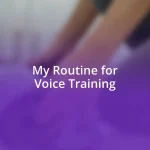Key takeaways:
- Music pedagogy is embracing technology and diverse cultural contexts, enhancing creativity and connection among students.
- Effective teaching methods include differentiated instruction, real-world connections, and fostering a growth mindset to engage students holistically.
- The future of music education is focused on innovation, collaboration, and inclusivity, encouraging students to express their identities through music.

Overview of Music Pedagogy Today
Music pedagogy today is navigating a transformative landscape shaped by technology and diverse teaching methodologies. I often think back to my early teaching days, where a simple metronome was my only tech tool. Now, we have apps that simulate entire orchestras! How incredible is that? This shift opens up endless possibilities for creativity in the classroom, allowing students to explore music in ways I could only dream of.
Incorporating diverse musical genres and cultural contexts has become essential in music education. I remember teaching a class where we explored global rhythms, and the students lit up with excitement, sharing their own cultural backgrounds. This approach fosters a sense of connection and relevance to their own lives, making music a powerful vehicle for self-expression. Isn’t it fascinating how music can bridge gaps and foster understanding among students from varied backgrounds?
Moreover, the emphasis on social-emotional learning in music pedagogy cannot be overstated. The emotional catharsis that music provides is something I truly value. Have you ever noticed how a single song can evoke a flood of memories? It’s vital for educators to recognize this power, using music as a tool for emotional growth and resilience in students. This perspective not only enriches their musical journey but also cultivates stronger, more empathetic individuals.

Key Trends in Music Education
It’s exciting to witness key trends emerging in music education that are reshaping how we teach and engage students. For instance, I recently attended a workshop on incorporating technology into lessons, and it blew my mind how virtual platforms can create immersive learning experiences. By using tools like digital composition software and online collaboration platforms, students are not just passive learners; they become active creators, bringing their own unique sounds and ideas to the table.
Here are some critical trends I’ve noticed:
- Integration of Technology: From recording projects to virtual classrooms, technology is enabling innovative teaching methods.
- Culturally Relevant Pedagogy: Emphasizing music from diverse backgrounds leads to a richer learning experience.
- Focus on Personal Expression: Students are encouraged to compose and perform original works, fostering creativity and individualism.
- Collaborative Learning: Group projects and ensemble playing promote teamwork and communication skills.
- Social-Emotional Learning: Music is increasingly seen as a pathway to emotional awareness and resilience among students.
Reflecting on these trends, I can’t help but feel hopeful about the future. When I see students excited about exploring their identities through music, it brings me immense joy. The classroom transforms into a vibrant community where every voice matters, and that’s truly where the magic happens!
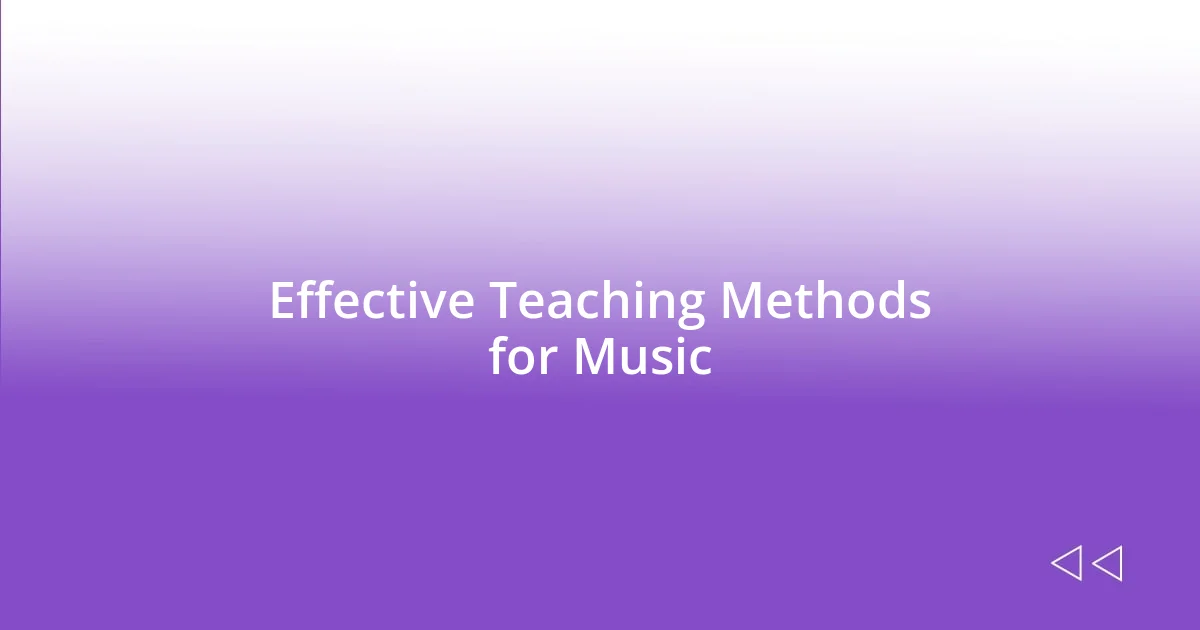
Effective Teaching Methods for Music
When it comes to effective teaching methods for music, I often find that differentiated instruction is key. I’ve had the experience of working with students who thrive in different environments; some are visual learners while others grasp concepts best through auditory means. Tailoring my lessons to accommodate these varied learning styles makes a noticeable difference in student engagement. For example, I once had a student who struggled to understand rhythm until we created a visual chart together, turning his frustration into excitement. This approach not only boosts confidence but also fosters a more inclusive learning environment.
Another method I’ve found to be impactful is the use of real-world connections. I remember inviting a local musician to share their journey with my class, and the students were completely captivated. Hearing about the musician’s struggles and triumphs made them realize that they, too, could follow a path in music. This method cultivates a personal connection to the material, reinforcing the idea that music isn’t just notes on a page; it’s a living, breathing art form.
Lastly, fostering a growth mindset in students can transform their approach to learning music. I often remind them that every musician encounters challenges along the way. I recall a student who almost quit after struggling with a challenging piece, but with encouragement and practice, she finally mastered it. The joy and pride she felt when she performed it flawlessly were indescribable. In this way, cultivating perseverance not only enhances musical skills but also builds character.
| Teaching Method | Description |
|---|---|
| Differentiated Instruction | Adapting lessons to align with various learning styles. |
| Real-World Connections | Involving musicians or real-life experiences to engage students. |
| Growth Mindset | Encouraging resilience and perseverance in learning. |
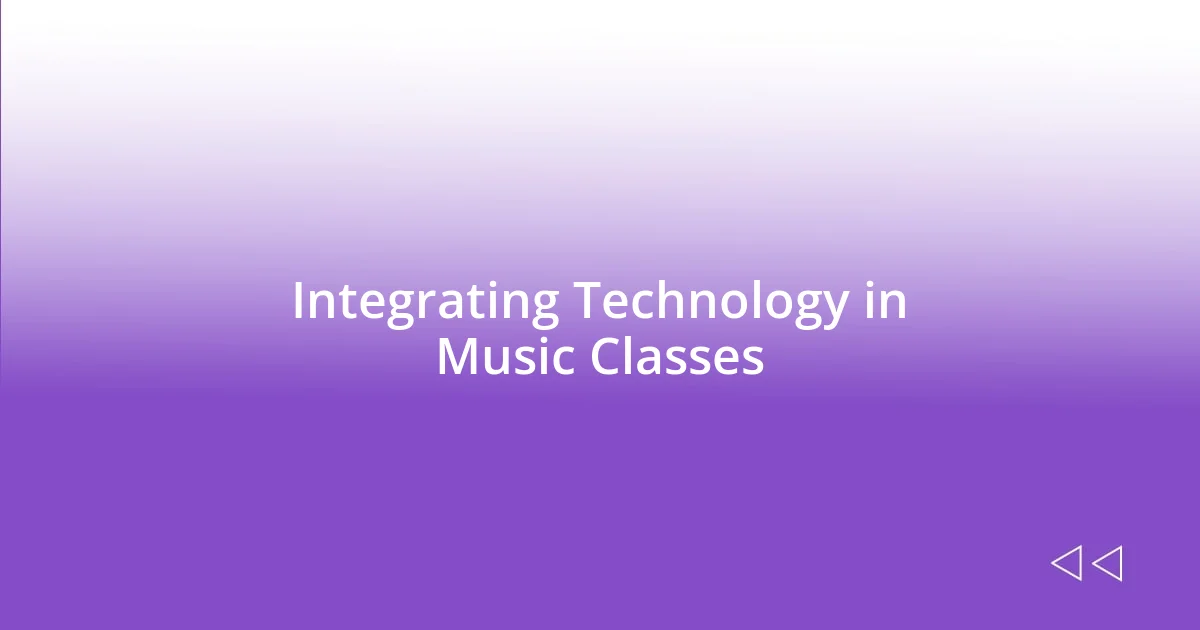
Integrating Technology in Music Classes
Integrating technology into music classes feels like opening a treasure chest of possibilities. I recently experimented with a digital audio workstation in my classroom, and the students were amazed at how they could layer sounds to create unique compositions. Isn’t it fascinating how these tools allow them to express their creativity in ways we never could just a decade ago?
Beyond composition, I’ve found that virtual collaboration can be incredibly powerful. I set up a project for my students to work with peers from another school, and witnessing them share ideas through video calls was truly inspiring. They learned not just about music but also about effective communication and teamwork, echoing real-world experiences they’ll carry into their futures.
Of course, it’s also essential to balance technology with traditional skills. I once had a student who became too reliant on the software for everything. When I introduced him to ear training exercises, which felt foreign to him at first, he quickly discovered the joy of recognizing pitches and harmonies without technology. This blend of old and new not only enhances their musicianship but cultivates a deeper appreciation for the art form itself.

Importance of Student Engagement
Student engagement is the heartbeat of effective music education. I’ve often noticed that when students feel genuinely involved, they can’t wait to participate. For instance, during one class, I opened up a discussion about their favorite music genres. The energy was electric as they passionately debated which artist deserved the crown—this kind of lively interaction inevitably leads to deeper insights and understanding of musical concepts.
Moreover, when students contribute their personal experiences to discussions, the classroom becomes a richer tapestry of ideas. I remember a time when a student shared her journey of learning a difficult song that had significant emotional value to her. As she spoke, I could see others leaning in, hanging on to her every word. That moment not only provided a bonding experience but also made the lesson on interpreting emotional expression in music so much more impactful. How often do we get to see students connect like that?
Creating opportunities for student-driven projects can be a game-changer in fostering engagement. I once assigned a group project where students had to compose and perform original pieces related to their daily lives. Watching them brainstorm ideas and collaborate felt like witnessing a mini revolutionary movement. It was inspiring to see them take ownership of their learning, and the diverse styles that emerged were proof of how much creativity flourishes when they feel invested. Isn’t it incredible how a little agency can lead to remarkable results in a music classroom?

Assessing Student Progress in Music
Assessing student progress in music can be a nuanced journey. I often find myself looking beyond just technical skills; it’s about understanding their growth as holistic musicians. For instance, during assessments, I like to incorporate reflective journals where students can express what they’ve learned and how they feel about their progress. It’s quite revealing—sometimes, they recognize their improvements faster than I do!
In my experience, combining formal evaluations with informal observations makes a significant difference. I remember a student who struggled with rhythm; he would tap his foot to a different beat than everyone else. I decided to assess him not just through tests but by observing his participation in group activities. Over time, his confidence blossomed as he found ways to contribute to ensemble performances. It was a valuable reminder that progress isn’t always measured by grades—it can manifest in collaboration and shared joy.
I’ve also seen the merits of peer assessments in fostering a supportive environment. A few months ago, I implemented a system where students provided feedback to each other during practice sessions. The camaraderie was astounding! Watching them encourage one another, celebrate small victories, and constructively critique was a powerful testament to their progress. It’s made me wonder: how often do we let students take the reins in assessing not only their music but also their peer relationships? The results can be transformative.

Future Directions in Music Pedagogy
The future of music pedagogy is brimming with innovation, especially with the advent of technology. I vividly recall a workshop I attended where we explored virtual reality in music education. The moment we put on those headsets, I found myself immersed in a breathtaking concert hall, feeling the vibrations of the music. It struck me how powerful such experiences can be in shaping students’ understanding of complex musical concepts. Could these technologies revolutionize how we teach music theory or history? I truly believe they can engage students in ways we’ve only dreamed of.
Collaborative learning is set to take center stage as well. In my own teaching practice, I noticed when students work together on compositions, they tend to push each other creatively. It’s fascinating to observe them share ideas, debate styles, and build off one another’s strengths. I once facilitated a jam session where students wrote a piece together, each contributing melodies that reflected their personalities. The synergy was palpable, and what emerged was a unique composition that none of them could have created alone. How often do we foster such collaborative environments in our classrooms?
Lastly, I see a shift toward inclusivity and diversity in music curricula. The music scene is a beautiful tapestry of genres and influences, and our teaching should reflect that. I often make it a point to include music from various cultures, and I once organized a multicultural day where students performed pieces from their heritage. The pride and enthusiasm on their faces were unforgettable. Isn’t it crucial for our students to see themselves represented in what they learn? Embracing diverse musical traditions could pave the way for more meaningful connections and broaden their appreciation for music as a universal language.

